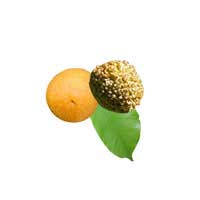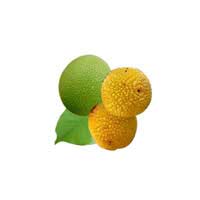 Full List of Fruits
Full List of Fruits  Mayan Nut
Mayan NutMayan Nut Fruit
![]() Introduction of Mayan Nut Fruit
Introduction of Mayan Nut Fruit
Scientific name - Brosimum alicastrum
Aboriginal to Latin America and the Caribbean, Mayan nut is known by several other local names such as the Ramon Nut, Breadnut, Ojoche, Ojite, Ojushte, Ujushte, Capomo, Manchinga, Sande, Pisba waihka, Huje and Mojo. The nut is the seed of Brosimum alicastrum which is not a true nut, having a neutral glycemic index they does not contain any allergenic compounds or alkaloids. The nut of this large tropical rainforest tree is naturally caffeine and gluten free and it is generally classified under the category of vegan and paleo.
Profuse throughout the region, it is one of the largest trees grown in the forests of Central America. Mayan people consumed the seeds of it and they were once a staple food for them. Forests areas, having been chopped down for timber and for maize, Brosimum alicastrum has become extinct. Loaded with calcium, potassium, folate, iron, zinc, protein and other micronutrients, they are extremely high in fiber as well.
Having its roots in the Moraceae family of flowering plants, the fruit i.e. the seeds fall off the tree between March and April. Giving away the smell of citrus, they are one of the favorite nuts of the forest creatures, particularly birds. With all that said, for up to five years, this wholesome nut can be stored. The best part about the tree is that they are an excellent drought and climate change-resistant food for rural communities. A whole village has survived eating this single nut, however in many areas, it is considered only as a 'famine foo' and there has been a decline in the consumption to less than five percent of local diets.
![]() Nutritional Value of Mayan Nut Fruit
Nutritional Value of Mayan Nut Fruit
The goodness of the nut is compared to quinoa, soy and amaranth. Consisting of Vitamin A, B, C and E, they are rich in calcium, potassium, fiber, protein, iron, zinc and frolic acid and is full of nutrients including antioxidants. Relative of the fig family, a single tree is said to produce 150-180kgs of fruits, moreover it remains productive for around 120-150 years. It is during the 8th year, the tree tends to bear fruit.
| Amount Per Serving | |
| Calories 217 | Calories from Fat 8 |
| % Daily Value* | |
| Total Fat 1g | 2 % |
| Saturated Fat 0g | 1 % |
| Trans Fat ~ | |
| Cholesterol 0mg | 0 % |
| Sodium 31mg | 1 % |
| Total Carbohydrate 46g | 15 % |
| Dietary Fiber ~ | |
| Sugar ~ | |
| Protein 6g | 12 % |
| Vitamin A 5% | Vitamin C 46% |
| Calcium 10% | Iron 12% |
![]() Health benefits of Mayan Nut Fruit
Health benefits of Mayan Nut Fruit
Loaded with countless health benefits, Maya nuts contain tryptophan which is a relaxing agent that helps fight insomnia. In addition, it also increases serotonin levels which in turn helps elevate mood and fight depression. Containing vital nutrients, they are good for infants and pregnant woman.
Furthermore, it contains protein, fiber, potassium for good blood pressure, calcium, magnesium, phosphorus, zinc, copper, iron, selenium for relaxation, vitamins A, B, C, and E.. and lots of powerful antioxidants that prevent cardiovascular disease, strokes, and cancer.
As aforesaid, they have very glow glycemic index, hence stabilizes blood sugar and lowers cholesterol in addition, also fiber helps with constipation and gives you a full feeling thereby helping you eat less.
The tree grows well in thick damp lowland tropical forests, with an average temperature of 25 degree centigrade and rainfall of around 1800mm. Despite the tree is inhabitant to moist rainforests, it has the capacity to endure drought and marginal soil. As a result, it is used for reforestation in many degraded sites. They grow naturally in rainforest soils.
Grown from the seeds, after more or less 30 days from sowing, 70 % of germination can be expected. It is needless to prune the branches, if in case you are growing the tree for its wood. On the other hand, if you are growing for its forage, then there comes a need for you to prune the branches when the saplings reach around 3m- 4m in height.


















